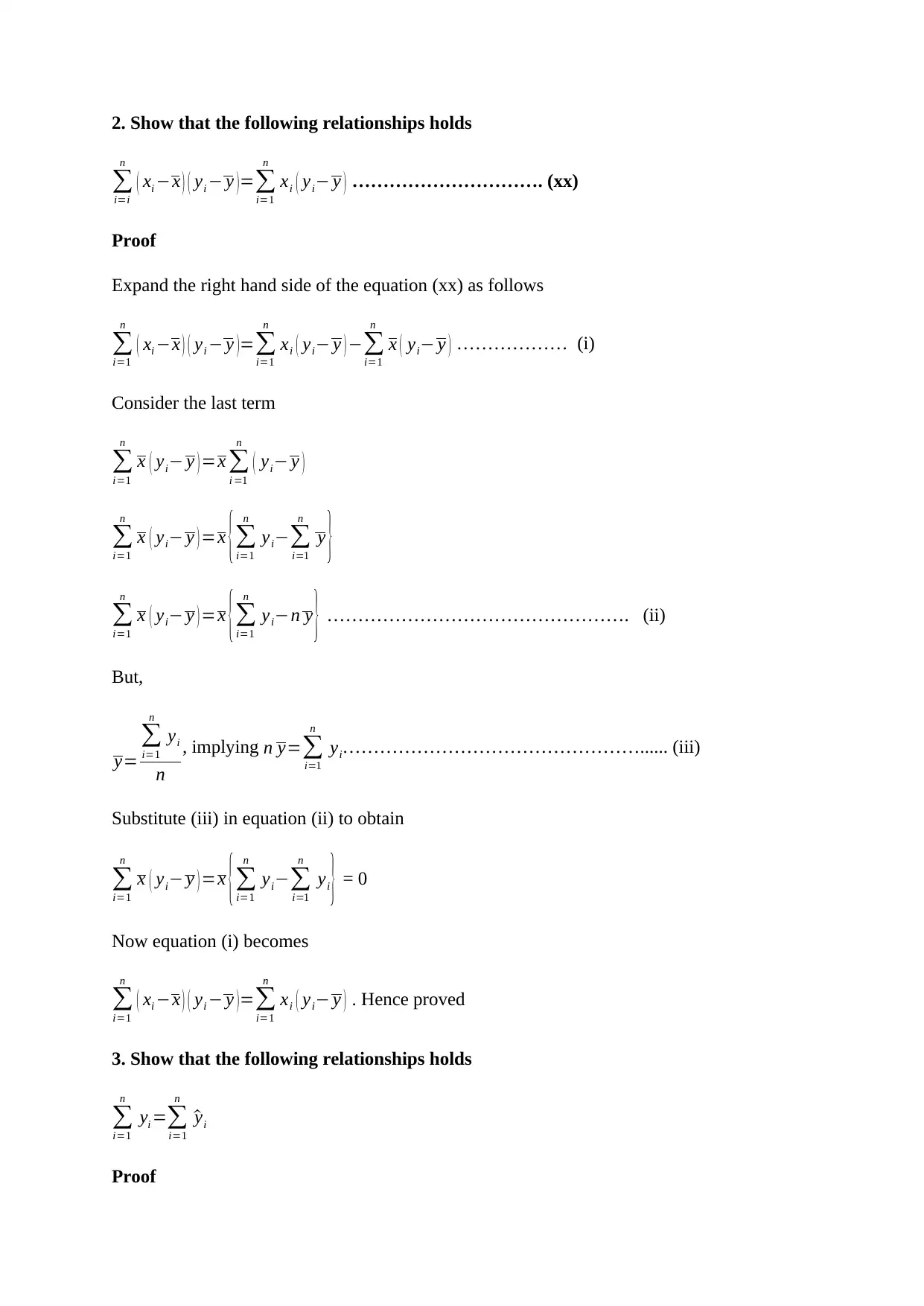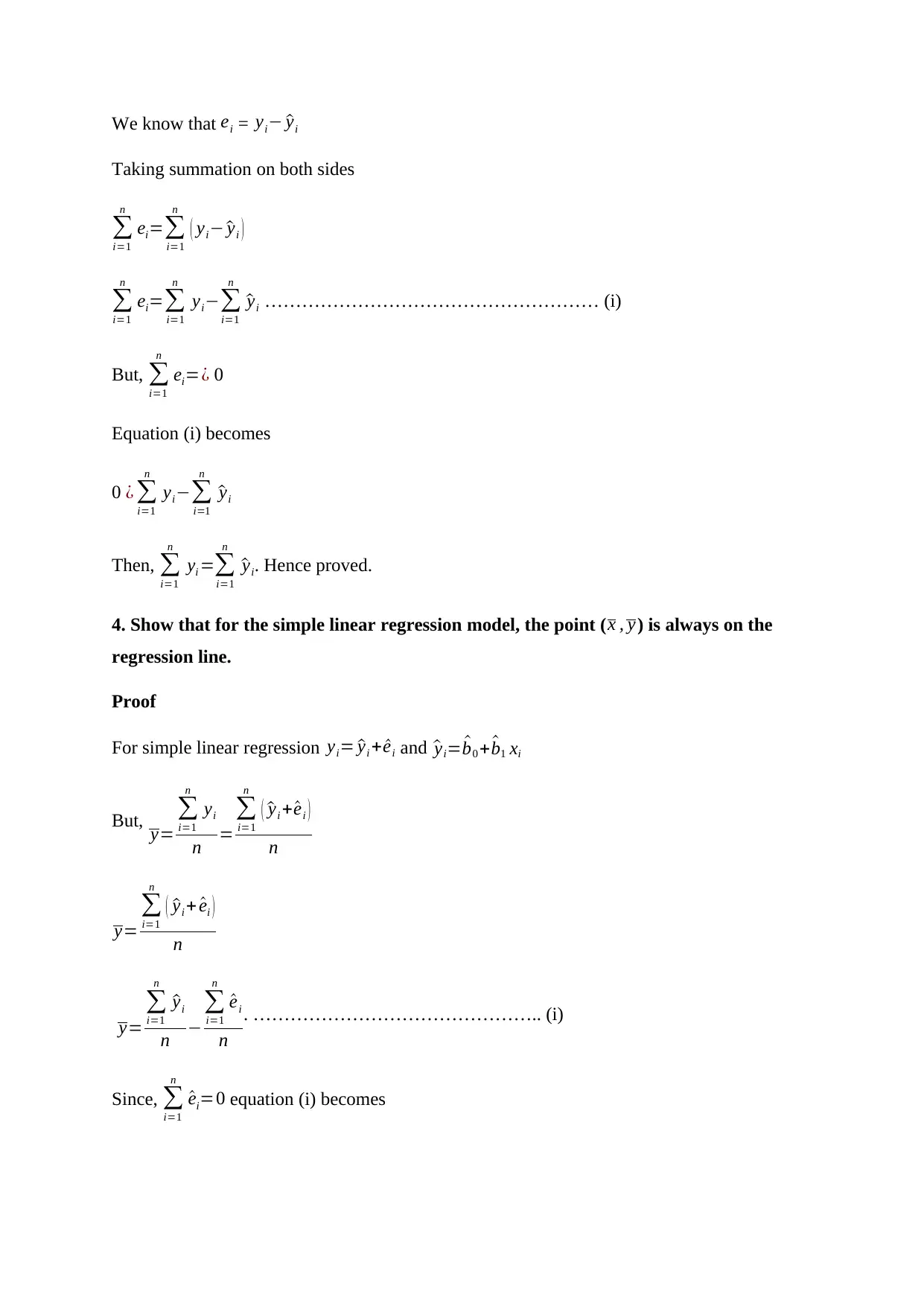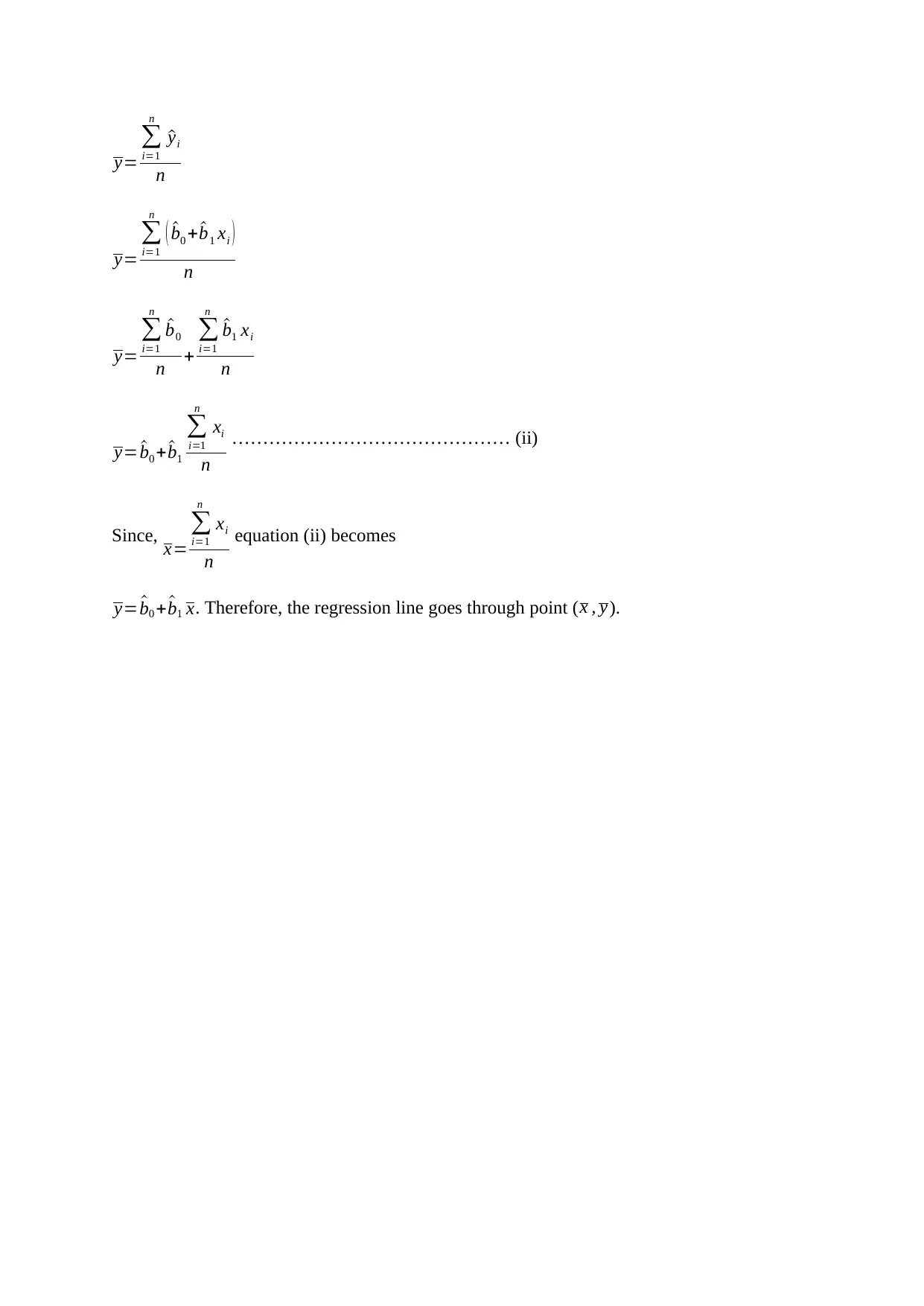Statistical Proofs in Simple Linear Regression Analysis Model
VerifiedAdded on 2023/06/04
|3
|533
|327
Homework Assignment
AI Summary
This assignment provides detailed proofs for several key relationships in regression analysis. It demonstrates that the sum of the product of deviations from the mean for x and y can be expressed as the sum of x_i multiplied by the deviation of y_i from its mean. It also proves that the sum of observed ...

2. Show that the following relationships holds
∑
i=i
n
( xi −x ) ( yi − y )=∑
i=1
n
xi ( yi− y ) …………………………. (xx)
Proof
Expand the right hand side of the equation (xx) as follows
∑
i=1
n
( xi −x ) ( yi − y )=∑
i=1
n
xi ( yi− y ) −∑
i=1
n
x ( yi− y ) ……………… (i)
Consider the last term
∑
i=1
n
x ( yi− y ) =x ∑
i =1
n
( yi− y )
∑
i=1
n
x ( yi− y ) =x {∑
i=1
n
yi−∑
i=1
n
y }
∑
i=1
n
x ( yi− y ) =x {∑
i=1
n
yi−n y } …………………………………………. (ii)
But,
y=
∑
i=1
n
yi
n
, implying n y=∑
i=1
n
yi…………………………………………...... (iii)
Substitute (iii) in equation (ii) to obtain
∑
i=1
n
x ( yi− y ) =x {∑
i=1
n
yi−∑
i=1
n
yi } = 0
Now equation (i) becomes
∑
i=1
n
( xi −x ) ( yi − y )=∑
i=1
n
xi ( yi− y ) . Hence proved
3. Show that the following relationships holds
∑
i=1
n
yi =∑
i=1
n
^yi
Proof
∑
i=i
n
( xi −x ) ( yi − y )=∑
i=1
n
xi ( yi− y ) …………………………. (xx)
Proof
Expand the right hand side of the equation (xx) as follows
∑
i=1
n
( xi −x ) ( yi − y )=∑
i=1
n
xi ( yi− y ) −∑
i=1
n
x ( yi− y ) ……………… (i)
Consider the last term
∑
i=1
n
x ( yi− y ) =x ∑
i =1
n
( yi− y )
∑
i=1
n
x ( yi− y ) =x {∑
i=1
n
yi−∑
i=1
n
y }
∑
i=1
n
x ( yi− y ) =x {∑
i=1
n
yi−n y } …………………………………………. (ii)
But,
y=
∑
i=1
n
yi
n
, implying n y=∑
i=1
n
yi…………………………………………...... (iii)
Substitute (iii) in equation (ii) to obtain
∑
i=1
n
x ( yi− y ) =x {∑
i=1
n
yi−∑
i=1
n
yi } = 0
Now equation (i) becomes
∑
i=1
n
( xi −x ) ( yi − y )=∑
i=1
n
xi ( yi− y ) . Hence proved
3. Show that the following relationships holds
∑
i=1
n
yi =∑
i=1
n
^yi
Proof
Paraphrase This Document
Need a fresh take? Get an instant paraphrase of this document with our AI Paraphraser

We know that ei = yi− ^yi
Taking summation on both sides
∑
i=1
n
ei=∑
i=1
n
( yi− ^yi )
∑
i=1
n
ei=∑
i=1
n
yi−∑
i=1
n
^yi ……………………………………………… (i)
But, ∑
i=1
n
ei=¿ 0
Equation (i) becomes
0 ¿ ∑
i=1
n
yi−∑
i=1
n
^yi
Then, ∑
i=1
n
yi =∑
i=1
n
^yi. Hence proved.
4. Show that for the simple linear regression model, the point ( x , y) is always on the
regression line.
Proof
For simple linear regression yi= ^yi + ^ei and ^yi= ^b0 + ^b1 xi
But, y=
∑
i=1
n
yi
n =
∑
i=1
n
( ^yi + ^ei )
n
y=
∑
i=1
n
( ^yi + ^ei )
n
y=
∑
i=1
n
^yi
n −
∑
i=1
n
^ei
n
. ……………………………………….. (i)
Since, ∑
i=1
n
^ei=0 equation (i) becomes
Taking summation on both sides
∑
i=1
n
ei=∑
i=1
n
( yi− ^yi )
∑
i=1
n
ei=∑
i=1
n
yi−∑
i=1
n
^yi ……………………………………………… (i)
But, ∑
i=1
n
ei=¿ 0
Equation (i) becomes
0 ¿ ∑
i=1
n
yi−∑
i=1
n
^yi
Then, ∑
i=1
n
yi =∑
i=1
n
^yi. Hence proved.
4. Show that for the simple linear regression model, the point ( x , y) is always on the
regression line.
Proof
For simple linear regression yi= ^yi + ^ei and ^yi= ^b0 + ^b1 xi
But, y=
∑
i=1
n
yi
n =
∑
i=1
n
( ^yi + ^ei )
n
y=
∑
i=1
n
( ^yi + ^ei )
n
y=
∑
i=1
n
^yi
n −
∑
i=1
n
^ei
n
. ……………………………………….. (i)
Since, ∑
i=1
n
^ei=0 equation (i) becomes

y=
∑
i=1
n
^yi
n
y=
∑
i=1
n
( ^b0 + ^b1 xi )
n
y=
∑
i=1
n
^b0
n +
∑
i=1
n
^b1 xi
n
y= ^b0 + ^b1
∑
i=1
n
xi
n
……………………………………… (ii)
Since, x=
∑
i=1
n
xi
n
equation (ii) becomes
y= ^b0 + ^b1 x. Therefore, the regression line goes through point ( x , y).
∑
i=1
n
^yi
n
y=
∑
i=1
n
( ^b0 + ^b1 xi )
n
y=
∑
i=1
n
^b0
n +
∑
i=1
n
^b1 xi
n
y= ^b0 + ^b1
∑
i=1
n
xi
n
……………………………………… (ii)
Since, x=
∑
i=1
n
xi
n
equation (ii) becomes
y= ^b0 + ^b1 x. Therefore, the regression line goes through point ( x , y).
You're viewing a preview
Unlock full access by subscribing today!
1 out of 3
Related Documents
Your All-in-One AI-Powered Toolkit for Academic Success.
+13062052269
info@desklib.com
Available 24*7 on WhatsApp / Email
![[object Object]](/_next/static/media/star-bottom.7253800d.svg)
Unlock your academic potential
© 2024 | Zucol Services PVT LTD | All rights reserved.





